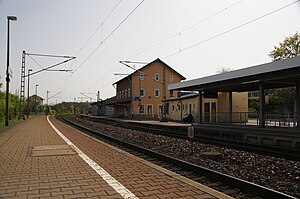Kirchheim (Neckar) railway station
| Kirchheim (Neckar) | |
|---|---|
 Kirchheim stop
|
|
| Data | |
| Operating point type | Breakpoint |
| Platform tracks | 2 |
| abbreviation | TKM |
| IBNR | 8003278 |
| Price range | 5 |
| opening | July 25, 1848 |
| Profile on Bahnhof.de | Kirchheim__Neckar_ |
| location | |
| City / municipality | Kirchheim am Neckar |
| country | Baden-Württemberg |
| Country | Germany |
| Coordinates | 49 ° 2 '15 " N , 9 ° 9' 2" E |
| Height ( SO ) | 180 m above sea level NHN |
| Railway lines | |
|
|
|
| Railway stations in Baden-Württemberg | |
The Kirchheim (Neckar) train station is located at 35.2 km of the Frankenbahn . According to the railway building and operating regulations, however, it is not a train station , but a stopping point .
history
As a connection from Stuttgart to Heilbronn , the Royal Württemberg State Railroad built the Northern Railway. Kirchheim, with around 1,700 inhabitants, was also to have a train station southeast of the village. The route ran along the left bank of the Neckar between Besigheim and Kirchheim . The state railway had to build a tunnel north of Kirchheim in order to get to Lauffen . On April 1, 1846, construction began on the Kirchheim area. For the route, the Fischergasse and parts of the old walling at the Neckartor had to give way.
The opening of the Northern Railway took place on July 25, 1848. The two-story station building, which is no longer in use today, but is still preserved, and the railway system were built at a height that is safe from flooding. The station master was also a mail expedition. A stagecoach operated between the postal expeditions in Kirchheim and Bönnigheim .
The population quickly recognized the advantages of the new means of transport. Craftsmen quickly got to the markets in Heilbronn or Ludwigsburg and were better able to sell their goods. Day laborers did not have to look for quarters in the big cities with their factories, but could live and commute with their families.
The Kirchheim tunnel required a second tube for the double-track expansion. On September 15, 1894, the State Railway put the second track between Bietigheim and Nordheim into operation.
Despite their proximity to the train station, the citizens of Neckarwestheim and Gemmrigheim had the disadvantage that only one ferry crossed the Neckar to Kirchheim. They had to pay an additional ferry fee per person and car. In 1894 there were talks between the mayors of Kirchheim, Neckarwestheim and Gemmrigheim. The three communities planned to build a bridge over the Neckar between Kirchheim and Gemmrigheim. In August 1895, King Wilhelm II signed the building permit. The bridge was inaugurated on September 2, 1897. This increased the number of goods to be loaded at the station.
In 1904 the Post set up Kirchheim's first telephone connection in the train station. On April 21, 1906, the state railway released the station master from the postal service.
On April 4, 1945 remaining troops of the Wehrmacht blew up the railway bridge over Mühlgasse. The effects were so severe that the surrounding houses were damaged. The Neckar Bridge was also blown up on April 8, 1945. Their reconstruction was delayed. Until the inauguration of the new bridge in 1950, there was again ferry service between Kirchheim and Gemmrigheim.
On June 1, 1959, the Deutsche Bundesbahn electrified the Bietigheim – Heilbronn section.
Rail operations
The stop is served by regional trains. The trains to Heilbronn, Neckarsulm, Bad Friedrichshall and Würzburg stop on platform 1, and those to Stuttgart on platform 2. In the outskirts of the day, the RE trains Stuttgart-Würzburg also stop in Kirchheim (Neckar).
The Kirchheim (Neckar) Bahnhof corresponds, according to the Deutsche Bahn AG of Bahnhof Category fifth
Regional traffic
After the transport companies Abellio Rail Baden-Württemberg and Go-Ahead Baden-Württemberg submitted the tender for the operation a. a. of the Neckar Valley network and thus replaced the DB Regio Baden-Württemberg , the railway lines were fundamentally revised for the timetable change in December 2019. Since then, Go-Ahead has been serving the RE 8 regional express line to Würzburg and Abellio the RE 10 and RB 18 lines to Mannheim and Osterburken .
Due to delivery problems for the Bombardier Talent 2 multiple units, Abellio was only able to partially implement the original timetable. With the 2019 timetable change, lines RE 10a and RE 10b will therefore start in Heilbronn instead of Tübingen . The RB 18 line begins in Stuttgart and is used by borrowed BR 425 trains. In order to still be able to guarantee a 30-minute cycle on the Stuttgart-Heilbronn route, DB Regio is temporarily operating the additional RE 10 line from Stuttgart to Heilbronn with double-decker cars on behalf of Abellio .
A progressive scenario of a traffic forecast presented in 2020 for the year 2030 envisages the extension of the S5 line of the Stuttgart S-Bahn with two trains per hour to Kirchheim.
literature
- Klaus Meeuw: 1000 years of Kirchheim am Neckar. Local chronicle 1003 to 2003. Published by the Kirchheim am Neckar community, Ungeheuer + Ulmer, Ludwigsburg 2003.
- Hans-Wolfgang Scharf: The railway in Kraichgau. Railway history between the Rhine and Neckar . EK-Verlag, Freiburg (Breisgau) 2006, ISBN 3-88255-769-9 .
Individual evidence
- ↑ Query of the course book route 780 at Deutsche Bahn.
- ↑ Stuttgarter Nachrichten, Stuttgart Germany: Stuttgarter Netze: Bahn is subject to bidding competition. Retrieved April 23, 2020 .
- ↑ Useful information for passengers on taking over additional lines in the Stuttgart network by Abellio | Abellio Germany. In: Abellio Baden-Württemberg. Retrieved April 23, 2020 .
- ^ Stefan Tritschler, Moritz Biechele: Update of the VRS traffic model. (PDF) Transport Science Institute Stuttgart, January 20, 2020, p. 9 f. , accessed on January 16, 2020 .